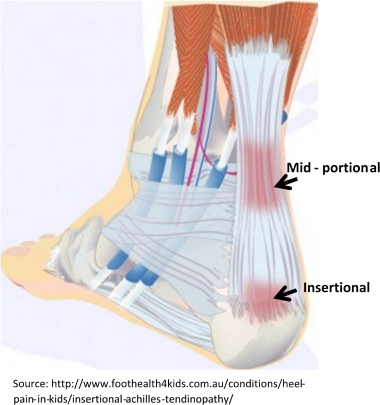The Achilles tendon attaches your calf muscles to the back of your heel. Achilles Tendinopathy used to be considered an inflammatory condition. However, while it may be associated with surrounding inflammation, recent studies suggest that it is actually tendon degeneration, often due to overuse or recent increase in activity levels. It may also be caused by the way your foot functions, which in turn may be putting excessive strain through the Achilles tendon.
may be associated with surrounding inflammation, recent studies suggest that it is actually tendon degeneration, often due to overuse or recent increase in activity levels. It may also be caused by the way your foot functions, which in turn may be putting excessive strain through the Achilles tendon.
Achilles tendinopathy is felt as pain at the back of your heel and can be classified as ‘insertional’ or ‘mid-portional’ depending which part of the tendon is affected. They are often managed slightly differently so it is important to listen to your podiatrist’s instructions very carefully, especially regarding how to do your exercises.
Achilles tendinopathy is usually accompanied by pain and morning stiffness. The pain may reduce after walking around for a while but often returns worse after you cease exercising.
Treatment from home:
- Rest, Ice, Elevation. While not necessarily an inflammatory condition, it can be associated with inflammation and these simple steps can help manage pain and reduce further strain. Some people find that heat packs help manage the pain too (but be careful not to burn yourself, especially if you’ve just used ice). Ask your podiatrist how you should modify your activity levels.
Treatment from you podiatrist may include:
- Orthotics if your foot structure or function are contributing factors. Treating the cause or contributing factors reduces strain to this area and prevents it from happening again.
- Heel raises to go in your shoes so that your Achilles tendon doesn’t have to stretch as much when you walk. Alternatively, the podiatrist may suggest you wear shoes with a mild block heel.
- Strapping your foot and/or extending this up your calf to prevent further stretching of the tendon to allow it to heal quicker and prevent further injury.
- Laser and/or therapeutic ultrasound to help shorten your recovery time.
- At some point in your rehabilitation, gentle exercises will be introduced to strengthen the tendon and help your recovery. Do your best to be diligent in completing these. They will strengthen the tendon to reduce pain and

Comments are closed.